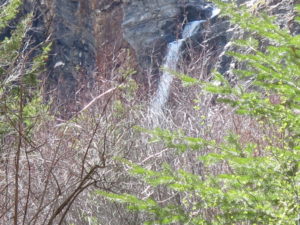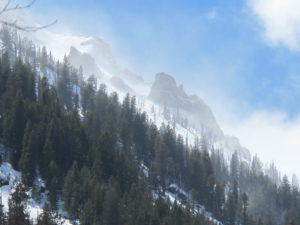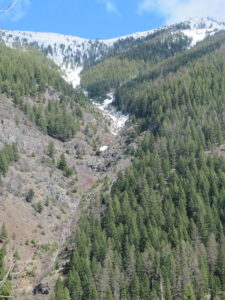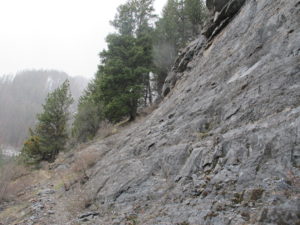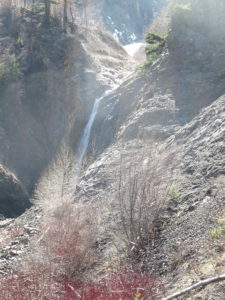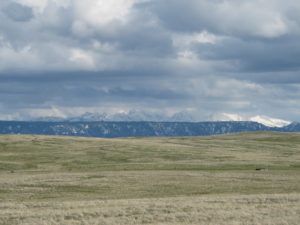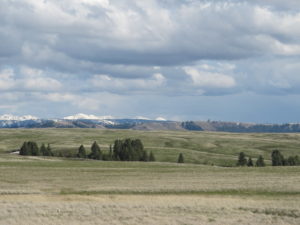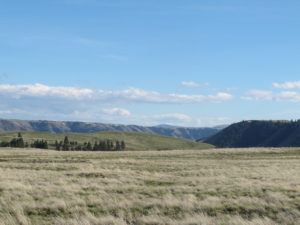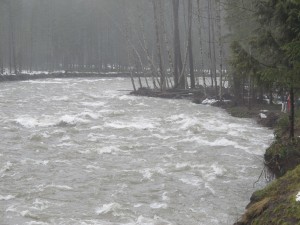Last Saturday I got to ride a mule as part of ongoing volunteer work to open up local trails in the Wallowas and Hells Canyon. Alas, I don’t have pictures, except in my mind.
I’ve been wanting to ride a mule for some time now, so when one team leader said he had an opening for a mule rider, I jumped for it. The mule in question was Bat, female, a half-Belgian sorrel mule from a Belgian draft mare and a standard jack, trained to drive, pack, and ride. She stands about 15.2 hands high (that is, 15 hands, two inches), probably weighs about 1300-1500 lbs, has big bones, and is an older mule.
We went up the Wing Ridge stock driveway which is on the east side of the Eagle Cap Wilderness. The trail is not meant for most hiker use–it goes straight up a steep ridge with only a few switchbacks. As it were, we stopped frequently to let our party of three mules (two ridden, one packing, all mature older equines) and one horse (three-year-old gelding, big and stout, working on getting wet saddle blankets and experience) catch their breath. And trim a few annoying branches here and there as well. During one stop, a mated pair of ruby-crowned kinglets landed in the lodgepole thicket just a foot away from me, so close that I could have touched them had I wanted to. The female had some sort of fluff in her beak and the male’s ruby crown was flared out in mating display. It took me a moment to identify them because I’d only seen them in winter coat before, not spring and summer. They didn’t seem to be bothered by a rider so close to them.
The area burned in a hot fire thirty years ago, so it is full of skeletal, whited snags and young lodgepole and Ponderosa regrowth. In one place, the wind blowing through the snags moaned and howled in a convincing imitation of wolf calls–something the team leader pointed out with a chuckle, because while there are wolves in the area, it was clear from the equine calmness that what we were hearing was trees and not wolves.
Bat and I had the brief discussions that come along with experienced equine used to carrying riders of all skill levels, that is to say, she threw some brief tests at me and I let her know that while I deferred to her judgement on some things, it wasn’t all going to be her way. She wasn’t happy about the young horse coming close to her hind end and pulled faces at him, tossing her head at him with pinned ears as a warning. Except for the bigger head and longer ears, Bat’s expression was darned near identical to Mocha’s in a similar situation. There’s something both comic and yet more threatening when that facial expression comes from a longears, though. Mules seem to have more expressive and comic faces, but those big pinned ears are a definite threat–until they flop. Going downhill, she also kicked at him several times, popping up her hind end for a double-barrel warning.
But she was also calm and sturdy, and definitely sure-footed. More sure-footed than Mocha? That’s not the difference. What really shows up as the big difference between Mocha and a mule or the stouter horses preferred here is durability and stability. Mocha is much smaller than Bat at 14.2 hands high and about 1000-1100 lbs at her heaviest. Her feet are tiny in comparison and she lacks the support of a sturdy, solid frame of a standard-sized mule like Bat or even the typical frame of the stout phenotype of horses preferred in these canyons. She’s not bred to work this country, and even though she’s catty-footed and strong, she would break down a lot sooner than Bat. Not her fault. Bat’s extra bone and sturdiness makes her more stable when going downhill and rider balance is not going to throw her off too much. Mocha needs a more experienced rider who can keep their balance because she’s so light in comparison. Seriously. I’ve ridden Mocha down similar steep slopes and I could tell that I needed to work much less with Bat where I would have either dismounted or aggressively maintained my balance with Mocha. Bat has the body to compensate for a bad step in those conditions. Mocha doesn’t. There were moments when I really noticed that difference with Bat.
So that was interesting.
That wasn’t all I learned from this work trip. The team leader is an experienced packer and the son of an experienced packer. He used the Decker packsaddle with clip-on canvas bags (carrying hard hats, clippers, axes, backpack, and pulaski), then dropped ropes on each side to secure the loads and tie a four-foot crosscut saw on top. I had lots of questions about packing and watched, wishing I’d had a camera to take even more pictures.
And I got to use the crosscut saw! First time for that. We had to leave the stock after about two miles and continue on foot for about another three-quarters of a mile due to snowbanks with uneven consistency. For the most part, humans could walk across the top of the occasional snowbank without sinking in, but there still was the occasional postholing moment. Not at all safe for stock, even led instead of ridden. The young horse Had A Moment in one snowbank but all came out well. Our goal was to eyeball one nasty fallen log just before the wilderness boundary and decide whether hand tools would be sufficient, or if a chainsaw was needed (okay because it was outside of the wilderness). The verdict was that the chainsaw was needed, especially since there were several other tough logs that would be best done by chainsaw before we got to that one problematic log.
We ended up cutting 7-8 big logs. The most challenging one was about 12 inches in diameter and had fallen across the trail to hang up in trees on the other side, at about 8 feet high. When we passed on doing the other log by hand we decided to do this one instead.
Then we headed downhill to a waiting barbecue. The mules and horse got their own version of the barbecue by getting to hand graze for a little bit before the humans went off for burgers and beer.
Dang, that was fun.

